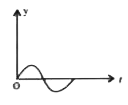When one of the slits of young's experiment is convered with a transparent sheet of thickness 4.8 mm, the central fringe shifts to a position originally occupied by the 30th bright fringe. What should be the thickness of the sheet if the central fringe has to shift to the position occupied by 20th bright fringe?Solution in Kannada
1.6 mm
3.8 mm
3.2 mm
7.6 mm
The correct Answer is:C
If with the introduction of a thin transparent medium, the fringe system gets a displacement of m fringes, then we have (μ−1)t=mλ.
For the first case,
(μ−1)×t1=m1λ . . . (i)
and for the second case,
(μ−1)×t2=m2λ . . (ii)
Dividing (ii) by (i), we get
t2t1=m2m1=2030
∴t2=2030×t1=2030×4.8mm=3.2mm.
Topper's Solved these Questions
Similar Questions
A balloon starts rising from thee ground with an acceleration of 1.25m/s2. After 8 s, a stone is released from the balloon. The stone will (taking g=10ms−2)
02:10View SolutionThe displacement time graph of a particle executing SHM is as shown in the figure. The corresponding force-time graph of the particle is-
 04:02View Solution
04:02View SolutionWhen one of the slits of Young's experiment is covered with a transparent sheet of thickness 4.8mm, the central fringe shifts to a position originally occupied by the 30th bright fringe. What should be the thickness of the sheet if the central fringe has to shift to the position occupied by 20th bright fringe?
01:32View SolutionIn a Young's experiment, one of the slits is covered with a transparent sheet of thickness 3.6×10−3cm due to which position of central fringe shifts to a position orginally occupied by 30th fringe. If λ=6000Å, then find the refractive index of the sheet.
04:11View SolutionA thin sheet of glass (refractive index 1.5) of thickness 6 microns, introduced in the path of one of the interfering beams in a double-slit experiment shift the central fringe to a position earlier occupied by the fifth bright fringe. The wavelength of light used is
05:58View SolutionA thin sheet of glass (mu=1.520) is introduced normally in the path of one of the two interfering waves. The central bright fringe is observed to shift to position originally occupied by the fifth bright fringe. If lambda=5890Å . Find the thickness of the glass sheet.
06:18View SolutionIn the Young's experiment, one of the slit is covered with a transparent sheet of thickness 3.6×10−3 cm due to which position of central fringe shifts to a position originally occupied by 30th bright fringe. The refractive index of the sheet, if λ=6000Å is
04:21View SolutionIn a young's double slit experiment, one of the slits is covered by a glass sheet of thickness 2.5xx10^(-5) m. Due to this, the position of the central bright fringe is shifted to position originally occupied by the 30th bright fringe. If lamda=5000 Å, then the refractive index of glass is
View Solutionजब यंग के द्वि-स्लिर प्रयोग में किसी एक स्लिट को 4.8 मिमी मोटी पारदर्शी पट्टी से ढक दिया जाता है, तो केन्द्रीय फ्रिन्ज, प्रारम्भिक आवी दीप्त फ्रिन्ज की स्थिति पर विस्थापित हो जाती है। यदि केन्द्रीय फ्रिन्ज को प्रारम्भिक 20वीं दीप्त फ्रिन्ज को स्थिति पर विस्थापित करना हो, तो पारदर्शी पट्टी की मोटाई होनी चाहिए
View SolutionA thin sheet of a transparent material (mu= 1.60) is placed in the path of one of the interfering beams in a YDSE using sodium light, lambda= 5890 dotA . The central fringe shifts to a position originally occupied by the 12th bright fringe. Calculate the thickness of the sheet.
03:00View SolutionA thin sheet of a transparent material (mu = 1.60) is placed in the path of one of the interfering beams in a YDSE using sodium light, lamda = 5890 Å. The central fringe shifts to a position originally occupied by the 12th bright fringe. Calculate the thickness of the sheet.
04:53View SolutionIn a Young's experiment, one of the slits is covered with a transparent sheet of thickness 3.6xx10^(-3)cm due to which position of central fringe shifts to a position originally occupied by 30th fringe. If lambda=6000 Å , then find the refractive index of the sheet.
03:19View SolutionIn a Young's experiment, one of the slits is covered with a transparent sheet of thickness 3.6×10−3cm due to which position of central fringe shifts to a position originally occupied by 30th fringe. If λ=6000Å, then find the refractive index of the sheet.
02:55View SolutionWhen one of the slits of Young's experiment is covered with a transparent sheet of thickness 4.8mm, the central fringe shifts to a position originally occupied by the 30th bright fringe. What should be the thickness of the sheet if the central fringe has to shift to the position occupied by 20th bright fringe?
02:30View SolutionA thin sheet of glass (μ=1.520) is introduced normally in the path of one of the two interfering waves. The central bright fringe is observed to shift to position originally occupied by the fifth bright fringe. If λ=5890Å. Find the thickness of the glass sheet.
03:33View Solution

